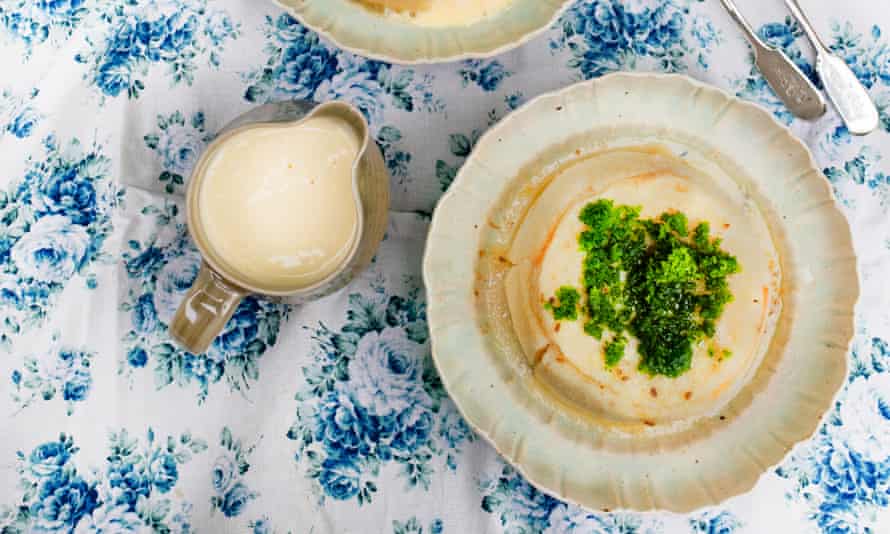
While I wait impatiently for the red and blackcurrants to appear in quantity and at a reasonable price, I make the traditional juice-saturated summer puddings with gooseberries instead. The first of our short-season summer fruits, their exceptional tartness is welcome, but can be softened with a little honey and a splash of elderflower cordial. My inclination is to serve them particular version with a jug of cream – in fact I would call it essential. Gooseberries, whether in a pie or a crumble, beg for cream rather than more piquant crème fraîche or yoghurt – which is why they make such a blissful fool.
The colour of such desserts, fools, ice-cream and this version of summer pudding is soft, reminiscent of a midsummer afternoon spent in the shade of the spreading canopy of a tree. You can lift this with a sprinkling of mint sugar, which will provide not only a splash of green but also a touch more sweetness for those who need it. I bring the pudding to the table with a jug of warm gooseberry juice sweetened with honey and one of cream, too.
The pale-green theme continues with the olive paste used to fill puff pastry tarts and their cargo of warm goat’s cheese. I chose to keep this recipe vegetarian, but you could introduce a few anchovy fillets – four is enough – if you fancy a little more piquancy. The paste is not only good for this, but also to serve with ravioli or, with a little more olive oil, as a dressing for pappardelle or other ribbon pastas.
A bowl of the olive paste is a jolly useful thing to keep in the fridge. Here at home the gorgeous, citrus-and-salt paste gets used as a dip for radishes and as a spread for carta de musica – the wafer-thin Italian crispbread – oatcakes and the like, but it also makes a deeply fragrant dressing for warm new potatoes for a salad.
Goat’s cheese and green olive tarts
You can prepare the olive paste for these tarts in advance, but you can also roll, cut and score the pastry cases, too. They can be kept in the fridge for a few hours until you are ready to bake. Makes 6 thin tarts
For the tarts:
flour for dusting
puff pastry 240g
egg 1, beaten
goat’s cheese 180g, soft
For the paste:
green olives 200g, stoned
basil 25g, leaves and stems
olive oil 75g
lemon 1
Line a baking sheet with baking parchment. Preheat the oven to 220C/ gas mark 8.
Lightly flour the work surface and roll out the pastry into a rectangle 30cm x 22cm. Have the long side facing you.
Cut the pastry sheet into 6 rectangles, roughly 15cm x 7cm. (In other words, cut the long side in half, then cut each of those lengthwise into 3.) Transfer the rectangles of pastry to the baking sheet, then score a rectangle inside each one, 1cm from the edge. Make sure not to cut through the pastry to the baking sheet.
Brush the outer rim of each piece of pastry with a little beaten egg, taking care not to let it run down the sides – it will prevent the pastry from rising. Bake in the preheated oven for 10 minutes.
Make the olive paste: put the olives in the bowl of a food processor, add the basil leaves and their stems and the olive oil. Finely grate the zest from the lemon and add to the bowl, then squeeze the lemon and add the juice. Process to a thickish paste.
With the pastry out of the oven, use the back of a spoon to carefully press down the centre, scored rectangle of pastry on each tart. Place 3 tbsp of the olive paste into each of the hollows.
Slice the goat’s cheese into thick rounds and place 2 or 3 on top of each tart. Bake for a further 10 minutes or until the cheese starts to melt. Eat warm.
Gooseberry pudding
A chilled, green summer pudding, its juices warmed and sweetened with honey. I sometimes add a sprinkling of mint sugar to the pale surface of the puddings – caster and mint leaves blitzed to a verdant green – and always serve them with a jug of cream or chilled custard – absolutely essential in my book.
Makes 4 individual puddings
gooseberries 850g
water 200ml
elderflower cordial 3 tbsp
white bread 6 thin slices
honey 2 tbsp
For the mint sugar (optional):
caster sugar 3 tbsp
mint leaves 12, medium
You will also need 4 deep china ramekins 8cm in diameter and some transparent kitchen film.
Remove the stems and dried flowers from the gooseberries, then put the fruit in a stainless steel or enamelled saucepan with the water and bring to the boil. Lower the heat and let the fruit cook for 5-7 minutes or until the fruit is opaque and soft. Remove from the heat and stir in the elderflower cordial.
Line the inside of the ramekins with plastic film with enough overhanging to fold over the top once they are filled with bread and fruit. Using an 8cm biscuit cutter, cut out 8 discs from the bread and place 1 in the base of each of four 8cm ramekins. Reserve the remainder.
Cut the remaining bread into 2cm-wide rectangles and use to line the sides of the ramekins, trimming as necessary. Fill the bread-lined ramekins with the gooseberries – pack them quite tightly and reserve any extra juice – then place the reserved discs of bread on top. Press down with a spoon to saturate the breads with juice. Fold the overhanging film over the top and place each ramekin on a tray. Place a second tray and a heavy weight on top then refrigerate overnight.
The next day, warm the reserved juice (there should be about 200ml) in a saucepan and stir in the honey. Turn the puddings out of their dishes into serving bowls or deep plates. Peel off the film, then spoon the warmed juice over the puddings and serve with cream or custard.
If you would like to make the mint sugar topping, whiz the sugar and mint in a food processor until the sugar is bright green. Sprinkle on top of the puddings as you bring them to the table.
Follow Nigel on Twitter @NigelSlater



